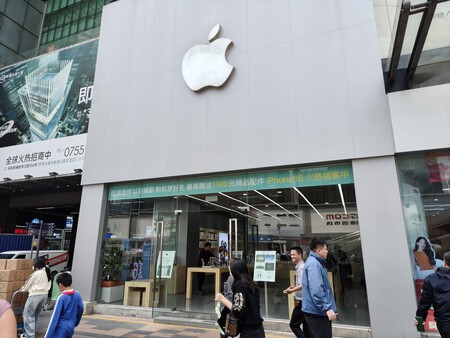The first (and only) time I went to Dubai, I felt like I was visiting a movie set. It grew from desert sands into a skyline of sci-fi towers in record time. Shenzhen gave me the same feeling.
Forty years ago, this southern Chinese city was a modest fishing village with a population of 310,000. Then Deng Xiaoping, China’s former military commission chairman, designated it a special economic zone to attract foreign investment—and Shenzhen took off.
 In just four decades, Shenzhen has transformed from a quiet fishing village into China’s Silicon Valley.
In just four decades, Shenzhen has transformed from a quiet fishing village into China’s Silicon Valley.
Today, it’s China’s Silicon Valley. With more than 23 million people and one of the country’s highest GDPs, the city buzzes with money. And like Dubai, it’s got an underbelly. While Dubai still has its souks and spice markets, Shenzhen has Huaqiangbei, a northern district known for electronics. There, you’ll find HQ-Mart, a six-story sprawl of counterfeit everything—one of the most overwhelming tech markets I’ve ever seen.
The Beating Heart of the Copy Market
 HQ-Mart entrance.
HQ-Mart entrance.
HQ-Mart covers more than 1.6 million square feet, houses over 12,000 stores, and is so big it’s impossible to explore in one day. From the outside, it looks like any modern mall. But step inside, and it quickly becomes clear that not everything is what it seems.
The first four floors cater to regular shoppers, while the top levels feel like trade show floors for wholesale dealers. It’s like a massive flea market buzzing with intellectual property violations. I saw LED-screen backpacks playing bootleg Pikachu animations—Nintendo lawyers would have a field day—and that was just in the first aisle.
 Fake DJI drones.
Fake DJI drones.
There are some legitimate stores: Huawei, DJI, Xiaomi, JBL. But walk upstairs, and you’ll see drones that look like DJI models but definitely aren’t. The contrast is jarring. You’ll find clean, official storefronts side-by-side with alley-style stalls selling knockoffs under flickering lights.
The hot items? iPhones, Dyson hair dryers, and smartwatches. There were earbuds everywhere, but the fake AirPods Max stood out—down to the carrying case, they looked shockingly real.
 Fake Dyson hairdryers.
Fake Dyson hairdryers.
At one point, I walked into a Dyson knockoff shop. Since I don’t speak Chinese and the sellers didn’t speak English, negotiations were done calculator-style: They typed a number, I typed another, and so on. I didn’t plan to buy anything—just to see how far the game would go.
 Fake products from Shenzhen’s HQ-Mart.
Fake products from Shenzhen’s HQ-Mart.
The original Dyson Supersonic Dryer retails for around $430. The knockoff? They were ready to let it go for just over $20. Honestly, I probably could’ve shaved that down even further if I’d pushed a bit harder. The funniest part? After we landed on a price, the shopkeeper looked at me and asked, dead serious, “How many do you want?” I was stunned—how many? I muttered some excuse and bailed without buying anything.
 The typical Mac running Windows 10.
The typical Mac running Windows 10.
A few stores later, I stumbled upon what looked like used MacBooks. Then I noticed one of them was running Windows 10—not in a virtual machine, just plain Windows on what looked like an Apple shell. That, plus a fake Apple Watch Ultra with generic RTOS software inside, were probably the wildest tech fakes I saw all day.
 At first glance, it looks identical to a real Apple Watch—but the moment you power it on, the illusion disappears.
At first glance, it looks identical to a real Apple Watch—but the moment you power it on, the illusion disappears.
I even saw handheld consoles like the R36S, a blatant clone of the Anbernic RG353VS. These came preloaded with games, which, while not technically illegal emulators, were definitely not above board.
 Spoiler: This isn't an Apple Store.
Spoiler: This isn't an Apple Store.
 The font choice that violated every principle of Apple design—and probably made designer Jony Ive cry.
The font choice that violated every principle of Apple design—and probably made designer Jony Ive cry.
Before leaving HQ-Mart, I stopped by its very own “Apple Store.” It had the glass and white interior—but the faded Apple logo and janky signage were the giveaways. I tested an iPad mini and a few iPhones. Visually and functionally, they were spot-on. But the feel? Not quite right. If those weren’t real Apple products, they were easily the best fakes I’ve ever seen.
A Whole Other World of Fakes
Electronics aren’t the only draw. The clothing scene might be even more intense at the Luohu Commercial City, another sprawling mall in Shenzhen. Unlike HQ-Mart, Luohu doesn’t flaunt its fakes so openly. It felt... gloomier. Less chaotic, more secretive.
 Luohu Commercial City.
Luohu Commercial City.
Stalls were hidden behind curtains or locked doors. Tourists were escorted in one by one by salespeople, and I followed one woman into a concealed shop after asking about handbags. What I found was a counterfeit boutique—wall-to-wall knockoffs of Celine, Prada, Burberry, Louis Vuitton—each shown in a detailed catalog referencing the original models.
Some bags were in-store, but most were kept in nearby warehouses. If you wanted it, they’d go get it.
 A Louis Vuitton Speedy 20 with shoulder strap—retail price: $2,070. I was holding an identical one inside that store.
A Louis Vuitton Speedy 20 with shoulder strap—retail price: $2,070. I was holding an identical one inside that store.
These bags felt real. Maybe a trained luxury shopper could spot a seam or misprint, but most casual shoppers wouldn’t know the difference. I held a Burberry handbag that could’ve fooled me completely—except for a slightly overdone logo print.
I started haggling, even though I didn’t plan to buy. They asked 800 yuan (about $110) for a Louis Vuitton bag and 600 yuan ($80) for a Burberry. I offered 480 yuan ($65) for both. The shopkeeper stood up, insulted. I walked out.
 Balenciaga’s Agaicnelab Oversize Fit T-shirt for men retails at $795. I spotted it—on full display—in more than a couple of shops in this mall.
Balenciaga’s Agaicnelab Oversize Fit T-shirt for men retails at $795. I spotted it—on full display—in more than a couple of shops in this mall.
But as I reached the mall exit, the same woman chased me down. She barely spoke English, but knew enough to bargain. She handed me the bags for the 480 yuan I offered. I didn’t take them—but it showed how elastic the pricing really is.
I also spotted shopkeepers hiding their merchandise as a man with a badge walked the aisles. He looked like some kind of inspector, but whether he was real or just for show, I couldn’t say.
Welcome to the Superfake Era
According to the OECD, counterfeit goods cost the global luxury industry between $55 billion and $70 billion each year. Handbags, wallets, and clothing account for about 60% of that market. In 2019 alone, the global counterfeiting industry was valued at $464 billion—roughly 2.5 percent of all international trade. That’s the economic equivalent of the GDP of a country like Belgium or Austria.
Still, the reality is this: counterfeiting thrives. And oddly enough, these markets have a kind of touristy charm. At least in the spots I visited, it wasn’t locals doing the shopping—it was people like me, curious outsiders poking around.
President Donald Trump’s tariffs on China only amplified the issue, pushing counterfeiting even further into the spotlight—especially on platforms like TikTok. There, Chinese merchants openly sell knockoffs that are nearly indistinguishable from the originals, often at a fraction of the price. These so-called “super fakes” mimic not just the look, but the materials and craftsmanship too—posing a serious challenge for luxury brands.
Images | Xataka On




